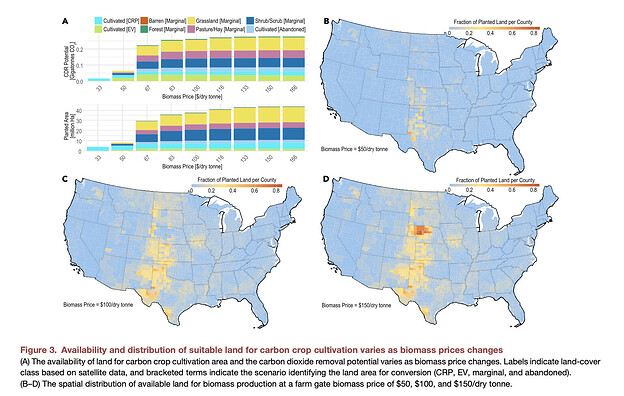Land-based resources for engineered carbon dioxide removal in the United States exceed the expected needs
This week, we deep dive into a paper recently published in One Earth. The study was led by Tao Dai, affiliated with the Economics & Agronomy Division of Life-Cycle, and the Biological Systems & Engineering Division of the Lawrence Berkeley National Laboratory in California (United States).
This study evaluates whether the contiguous United States has sufficient land resources to meet engineered carbon dioxide removal (CDR) goals via two engineered strategies requiring significant land use, energy supply integration, and CO₂ storage access: Biomass Carbon Removal and Storage (BiCRS) and Direct Air Capture and Storage (DACS).
The study makes a timely and policy-relevant contribution to the engineered CDR literature by providing a spatially explicit assessment of land suitability across the contiguous United States. It offers the first detailed, empirical estimates of how much land is available for two prominent engineered CDR strategies— BiCRS and wind- or solar-powered DACS—while accounting for competing land uses, food production, and ecological conservation. By integrating biophysical, energy, and storage constraints, the analysis supports infrastructure planning and informs regional CDR deployment strategies. The study also identifies regions where BiCRS and DACS can be co-located, presenting opportunities for shared infrastructure and cost efficiencies. These overlapping zones—primarily in parts of the Midwest, Gulf Coast, and interior West—feature suitable land, access to renewable energy, and proximity to geologic CO₂ storage. Co-location could reduce logistical complexity and accelerate deployment, especially if planning accounts for synergies in transportation, storage, and workforce development.
The main finding is that the land-based resource potential for engineered CDR in the U.S. substantially exceeds projected national needs. Approximately 37.6 million hectares are available for BiCRS, which could remove around 0.26 gigatons of CO₂ per year. Even more notably, around 34 million hectares are suitable for siting DACS systems powered by renewable energy, with the capacity to remove up to 4.8 gigatons of CO₂ annually if co-located with geologic storage. The study also identifies key geographic “hotspots” where land, renewable energy, and CO₂ storage align, offering high-leverage opportunities for deployment that minimize conflict with agriculture and sensitive ecosystems.
While the study shows strong biophysical potential for engineered CDR, its deployment will depend on costs, infrastructure, public support, and policy. It doesn’t assess economic feasibility or life-cycle impacts, and emphasizes that CDR must complement—not replace—emissions cuts. Still, the findings suggest land availability is unlikely to limit large-scale CDR in the U.S.
Here is a list of the main takeaways of this paper:
- U.S. land availability is not a limiting factor for engineered carbon dioxide removal; supply exceeds projected national CDR needs.
- Biomass and renewable-powered direct air capture could remove up to 0.26 and 4.8 gigatons of CO₂ per year, respectively.
- Geographic “hotspots” offer ideal siting where land, renewable energy, and CO₂ storage potential align with minimal trade-offs.
- Food production and ecosystem protection constraints were integrated, ensuring realistic and responsible land-use assumptions.
Policy, infrastructure, and public support remain critical for turning this technical potential into real-world carbon removal capacity.
Read the full paper here: Land-based resources for engineered carbon dioxide removal in the United States exceed the expected needs
